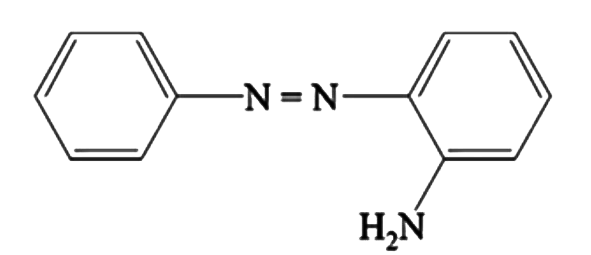Benzene diazonium chloride on reaction with aniline in the presence of dilute hydrochloric acid gives :




The correct Answer is:C
To solve the question, we need to analyze the reaction between benzene diazonium chloride and aniline in the presence of dilute hydrochloric acid.
1. Identify the Reactants:
- The reactants are benzene diazonium chloride (C6H5N2Cl) and aniline (C6H5NH2).
2. Understand the Reaction Conditions:
- The reaction occurs in the presence of dilute hydrochloric acid (HCl). This acid helps to maintain the stability of the diazonium salt.
3. Mechanism of the Reaction:
- Benzene diazonium chloride (C6H5N2Cl) is a strong electrophile due to the presence of the diazonium group (N2+).
- Aniline, which has an amino group (-NH2), acts as a nucleophile. The lone pair of electrons on the nitrogen atom of aniline can attack the electrophilic diazonium ion.
4. Formation of the Coupling Product:
- When aniline reacts with benzene diazonium chloride, the amino group of aniline attacks the diazonium ion, leading to the formation of a coupling product.
- The reaction can be represented as follows:
C6H5N2Cl+C6H5NH2→C6H5−N=N−C6H5−NH2+HCl
- The product formed is a substituted azo compound, specifically an azo dye, which has the structure:
C6H5−N=N−C6H5−NH2
- This product is known as an azo compound due to the presence of the -N=N- (azo) group.
5. Conclusion:
- The final product of the reaction is an azo compound formed by the coupling of aniline with benzene diazonium chloride.
Final Answer:
The reaction of benzene diazonium chloride with aniline in the presence of dilute hydrochloric acid gives an azo compound.
- The reactants are benzene diazonium chloride (C6H5N2Cl) and aniline (C6H5NH2).
- The reaction occurs in the presence of dilute hydrochloric acid (HCl). This acid helps to maintain the stability of the diazonium salt.
- Benzene diazonium chloride (C6H5N2Cl) is a strong electrophile due to the presence of the diazonium group (N2+).
- Aniline, which has an amino group (-NH2), acts as a nucleophile. The lone pair of electrons on the nitrogen atom of aniline can attack the electrophilic diazonium ion.
- When aniline reacts with benzene diazonium chloride, the amino group of aniline attacks the diazonium ion, leading to the formation of a coupling product.
- The reaction can be represented as follows:
C6H5N2Cl+C6H5NH2→C6H5−N=N−C6H5−NH2+HCl
- The product formed is a substituted azo compound, specifically an azo dye, which has the structure:
C6H5−N=N−C6H5−NH2
- This product is known as an azo compound due to the presence of the -N=N- (azo) group.
- The final product of the reaction is an azo compound formed by the coupling of aniline with benzene diazonium chloride.
The reaction of benzene diazonium chloride with aniline in the presence of dilute hydrochloric acid gives an azo compound.
Similar Questions
Benzenediazonium chloride on reaction with aniline in weakly basic medium gives
View SolutionBenzene diazonium chloride on reaction with phenol in a basic medium gives:
View SolutionBenzene diazonium chloride on reaction with phenol in weakly basic medium gives
View SolutionEthyl chloride on reaction with chlorobenzene in presence of Sodium and ether gives:
View SolutionBenzene diazonium chloride on boiling with dilute sulphuric acid, gives
View SolutionThe most reactive amine towards dilute hydrochloric acid is
View Solutionwhat is obtained when benzoyl chloride reacts with aniline in the presence of sodium hydroxide?
View SolutionThe reaction of toluene with chlorine in the presence of ferric chloride gives mainly
View SolutionThe treatment of benzene with isobutene in the presence of sulphuric acid gives
View SolutionWrite the reaction between zinc hydroxide and dilute hydrochloric acid
View Solution
